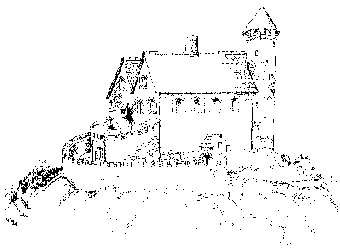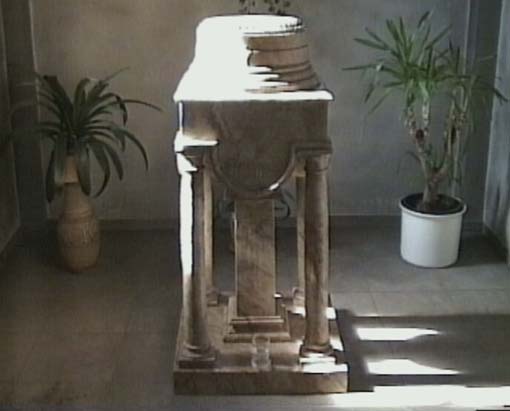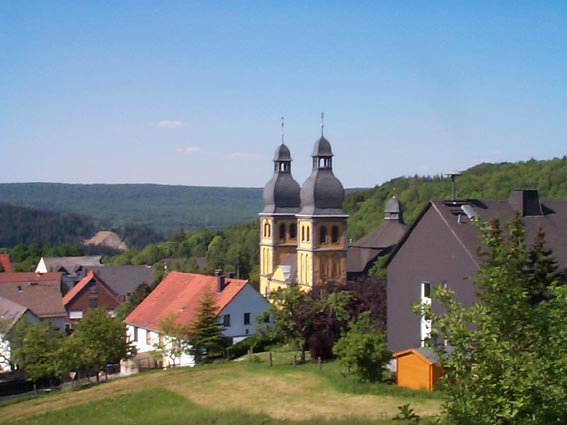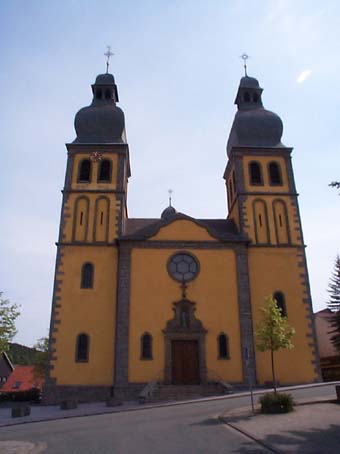|
|
|
|
|
|
|
The "Alte Hagen" |
At the top of the "Alter Hagen", the hill which people not from Padberg usually call the "Padberg Mountain", once was built the home of the noble / aristocratic family ‘von Padberg’.
|
|
|
|
|
|
|
The "Alte Hagen" |
At the top of the "Alter Hagen", the hill which people not from Padberg usually call the "Padberg Mountain", once was built the home of the noble / aristocratic family ‘von Padberg’.

Perhaps
the home looked like this.
|
Die
Burg zu Padberg / The Castle of Padberg Erected in the style of a saxonian “top of the mountain castle” before AD 1100, approximately between 1080 and 1100.
|
|
| June 1, 1030 | Earliest known charter, which names the property of Padberg and its owner Graf (count) Bernhard |
| 1120 | Earliest known charter which mentions the castle: Possession and castle are sold by Beatrix, widow of Count Erpo von Padberg, to the Archbishop of Cologne, Friedrich I. |
| 1165 | First seal of the feudal lords, which shows the typical elements in the coat of arms. |
| March 12, 1263 | The feudal lords Johann and Gottschalk von Padberg bestow the municipal rights to their citizens. These rights were renewed several times in the following centuries; the “Ring of Padberg” (the City) had his own church (St. Peter - mentioned the first time in 1057), which is not identical to the chapel within the walls of the castle. |
| 1330 | We know from the history, that the patron saint of the chapel in the castle was named for St. Adelgundis and it was with a lot of indulgences. Today the flat area in the north east of the former castle is known as the “Kapellenplatz” (place of the chapel). |
| Middle of 13th Century | The castle of Padberg was meant to be impregnable: it gets the title of “being one of the four columns of the Archbishopric of Cologne”, which lasted to the end of the 14th Century. |
| End of 14th – middle of 15th century | The Padberg family knights change to robber knights, caused by economical distress. |
| March 1516 | The infamous Goetz von Berlichingen stays for three days as a guest of the Knights von Padberg at the castle. |
| April 1516 | Starting from the castle, Goetz attacks Count Philipp II von Waldeck in Dahlheim, taking prisoner and only setting him free a long time later after receiving a high ransom. (From that money he bought the castle Jagsthausen, which still is owned by the Berlichingen family.) |
| March 27, 1576 | In the “Salentin’s Rezess” it is stated, that the castle isn’t a fortress any longer. The knights von Padberg remain under obligation to the Archbishop of Cologne to be able to ready the castle for defense in war times. |
| About 1600 | The castle is not fit to live in any longer for the people. The Knights already have moved into the inner city of the “Ring Padberg”. |
| 17th Century | The deterioration of the castle continues. In the Thirty-years-war (1618-1648) the outer walls are used as rampart for musketeers. Otherwise the castle becomes a quarry from which the Padbergs take stones for their houses. |
|
Through all the centuries the Padberg castle was strong against attacks and siege by troops coming from Paderborn, Waldeck and Hessia. Against the “Tooth of Time” it couldn’t resist. |
|
The old church St. Peter in Padberg
Located at the border between plant covered hill “Alter Hagen” and the village of today you will find the church St. Peter, which actually is under re-construction.
|
|
|
|
view outside |
view inside |
In
AD 1030 Emperor Konrad III donated the “Praedium Padberg” (praedium: latin
for property) to Mainwerk, Bishop of Paderborn. In 1057 the oldest part of
romanic style already was built, which was enlarged later and gothic windows
were added. The giant column in the middle of the church is a remaining part
of the original exterior wall.
The
old church originally is dedicated to St. Peter. In the year 1264 a priest,
called Gottfried, is mentioned in documents. In later times that priest, also
had to hold services in Beringhausen, a neighbor village where he lived. But
during the week before Easter and at all other important holidays of the church,
he had to hold services in the Padberg parish church only.
|
 |
|
The baptism stone in the church of St. Maria Magdalena |
Also
the oldest three bells, the biggest engraved with the year 1684, are in the new
church. The figure of Our Lady and two praying angels were installed in the
places where the former altars stood. They also were made in the workshop of the
Pape family.
Since
the new church was built in the city, today there are services in the old church
only on special occasions including processions.
The new church of St. Maria Magdalena in Padberg

The actual Parish church of the “Ring Padberg” is dedicated to St. Maria Magdalena. It was built in 1912/13 and was consecrated by Bishop – later Cardinal – Schulte.
The
architectural style is Baroque in accordance to the baroque altars, which were
taken from the old church. The high altar containing the picture “Adoration by
the Shepherds” as well as the rich ornamented columns, which were made of
alabaster, were produced of the sculptor workshop of Heinrich Pape from
Giershagen. The figures of the St. Maria Magdalena and the St. Margareta are
sculpted from sandstone.
To
the parish belongs the community of Helminghausen, which has a “separate
trust” for that community. In 1906/07 a chapel was built there.
 |
|
The entry of St. Maria Magdalena |